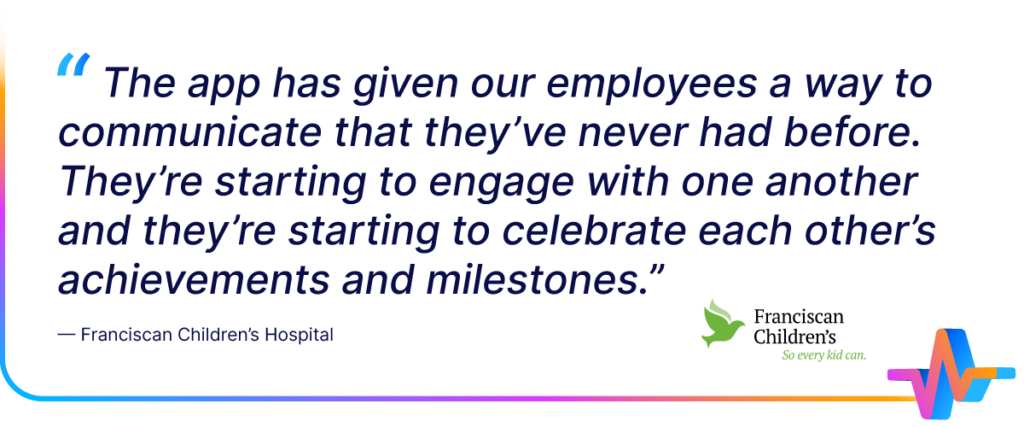First aid kit overview: A new approach to healthcare communication
In healthcare, effective communication is often the difference between calm and chaos. When your workforce feels informed and connected, patient care thrives — but when communication fails, confusion, errors, and burnout take hold. Just as a first aid kit is essential in emergencies, your organization needs the right communication tools to ensure clarity, confidence, and control.
This playbook equips healthcare leaders and communicators to drive success by empowering leadership and managers to deliver clear, consistent messaging that supports staff retention, crisis readiness, and improved patient outcomes. It ensures that employees — from frontline care teams to administrative staff — feel informed, valued, and connected to your organization’s mission.
With mobile-first communication strategies, you can bridge gaps between desk-based and frontline staff, ensuring critical updates reach every employee — no matter their role or location. This playbook also addresses the growing risks posed by digital overload and misinformation, offering solutions to improve focus and reduce errors in high-pressure environments.
What this first aid kit contains
This playbook is your ultimate guide to building effective communication in healthcare, combining practical resources, real-world examples, and actionable strategies designed to deliver measurable results.
- Essential tools: Templates, message mapping frameworks, and crisis communication checklists to keep communication clear and effective.
- Real-world insights: Case studies and examples from healthcare organizations that have tackled staffing challenges, crisis communication, and digital overload.
- Actionable steps: Simple, clear guidance to improve communication at every level — from onboarding to leadership visibility to emergency preparedness.
- Measurable outcomes: A focus on achieving real results — like improved retention, reduced errors, and stronger employee engagement — by connecting communication strategies to healthcare goals.
- Quick wins: Immediate, practical actions to tackle urgent communication challenges and build momentum for long-term improvements.
Your path to success
By adopting this healthcare communication framework, you will:
- Build a connected workforce where every employee — from nurses and doctors to administrative and support staff — has access to the information they need, when they need it.
- Foster an engaged culture where employees feel valued, supported, and aligned with your organization’s mission to provide exceptional care.
- Create confident advocates who trust your leadership, understand their role in delivering quality care, and feel empowered to make a difference every day.
Healthcare success starts with a workforce that is informed, engaged, and empowered. This playbook gives you the tools to make that goal a reality — one step at a time.

The healthcare industry is under immense pressure. From hospital wards to executive offices, leaders are navigating a landscape shaped by staffing shortages, digital transformation, and growing demands for patient care. Rising burnout rates, evolving care models, and an increasing number of cyber threats have created new challenges — and communication is critical to overcoming them.
According to the International Council of Nurses, the global nurse shortage could reach 13 million by 2030, and the World Health Organization estimates that 6.4 million more physicians are needed to meet universal health coverage goals. Meanwhile, 85% of health system CEOs anticipate major organizational changes in the coming years.
For healthcare leaders, this environment presents a dual challenge: caring for patients while also supporting an exhausted and overwhelmed workforce. Clear, consistent communication — delivered through modern, accessible channels — is essential for helping staff feel informed, valued, and connected.
The workforce crisis: Burnout, retention, and talent gaps
Healthcare’s staffing crisis continues to worsen. Whether in hospitals, nursing homes, or outpatient care centers, staffing shortages have reached critical levels — and the consequences are severe.
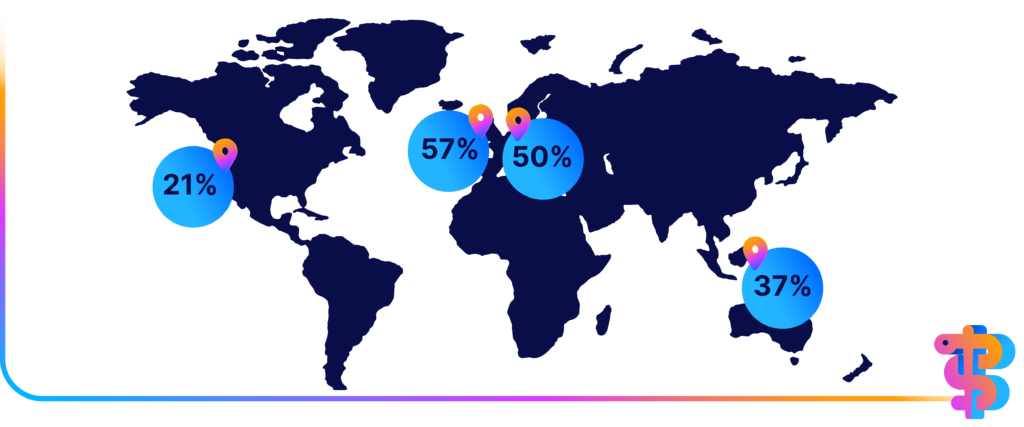
In the United States, hospital staff turnover averages 21% annually, costing organizations as much as $5.8 million per year. In the UK, 57% of nurses say they are considering leaving their roles, while in Germany, nearly half of hospital nurses expressed uncertainty about remaining in the profession over the next year. For Australia, 37% of nurses plan to leave their jobs within the next 12 months.
At the same time, younger healthcare professionals are hesitant to enter — or stay in — the industry. Concerns about burnout, inflexible work environments, and limited career growth contribute to a talent gap that puts further pressure on staff retention.
Without effective communication strategies, healthcare organizations risk losing staff at an alarming rate. By improving communication flow, leaders can build trust, demonstrate support, and ensure that employees feel seen and valued — all critical steps in addressing the talent crisis.
Digital overload and the need for better tools
While digital transformation promises to improve healthcare delivery, outdated communication tools are creating new risks. In fast-paced environments, nurses and doctors must constantly triage incoming information, making it difficult to separate urgent updates from routine messages. When communication feels chaotic, staff may miss critical instructions or safety updates.
Studies show that 80% of global workers report feeling overwhelmed by information overload. In the US, poor communication has been linked to 30% of medical malpractice cases, with communication errors contributing to costly mistakes and negative patient outcomes.
To reduce noise and improve focus, healthcare organizations must prioritize targeted, role-specific messaging — ensuring employees get only the information that’s relevant to them, through the channels they use most.
Crisis communication: Protecting patients, staff, and operations
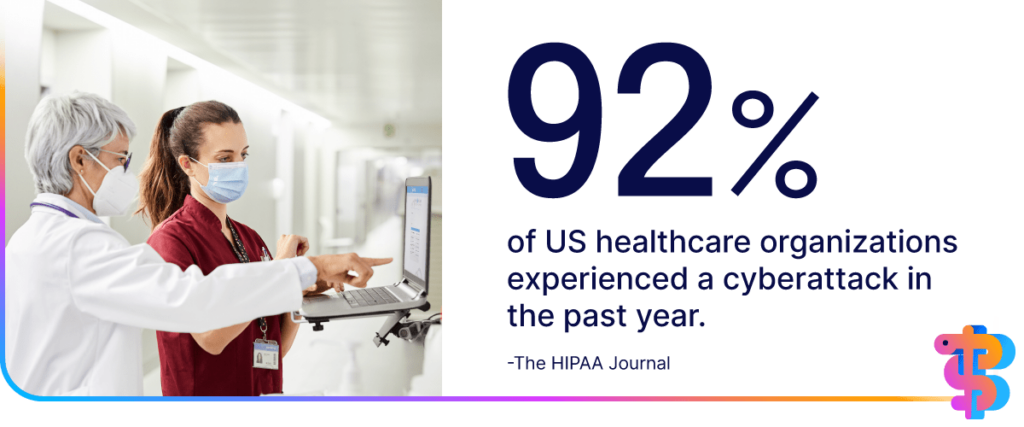
Healthcare organizations are increasingly vulnerable to crises — from cyberattacks to natural disasters to unexpected medical emergencies. In fact, 92% of US healthcare organizations experienced a cyberattack in the past year, with 69% reporting that patient care was disrupted as a result.
During a crisis, communication is essential to protecting both employees and patients. Yet traditional methods — such as bulletin boards, manager cascades, or email-only updates — are often too slow to keep pace with urgent situations.
In moments of disruption, fast, reliable communication tools — like branded push notifications and SMS alerts — ensure employees get the information they need in real time. Whether it’s an unexpected power outage, a data breach, or an urgent patient care update, staff must know exactly what’s happening and what actions to take.
The communication gaps holding healthcare back
Despite the clear need for improved communication, healthcare organizations still rely heavily on outdated tools that fail to meet the needs of busy frontline staff.
Many nurses, doctors, and support staff are disconnected from traditional email-based communication. Instead, they rely on word-of-mouth updates, paper notices, or scattered digital channels — leaving gaps in knowledge that increase risks to both staff and patients.
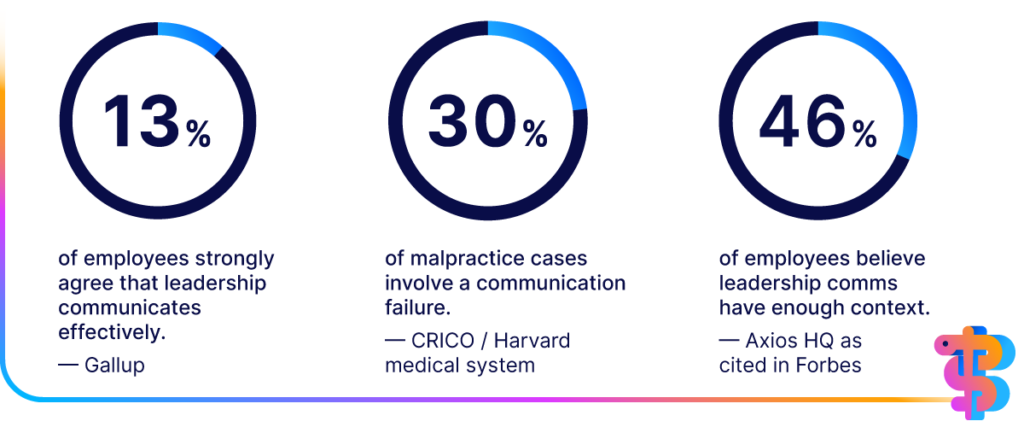
Communication breakdowns have serious consequences: 30% of malpractice cases involve a failure in communication, according to the CRICO/Harvard medical system. Internally, the disconnect is just as striking. Only 13% of employees strongly agree that leadership communicates effectively with the rest of the organization, as reported by Gallup. And while 77% of leaders believe they provide the necessary context in their messaging, just 46% of employees agree — a significant gap that highlights the need for more effective and empathetic communication according to Axios HQ, as cited in Forbes).
When employees lack access to clear, timely information, trust erodes, engagement drops, and patient care suffers.
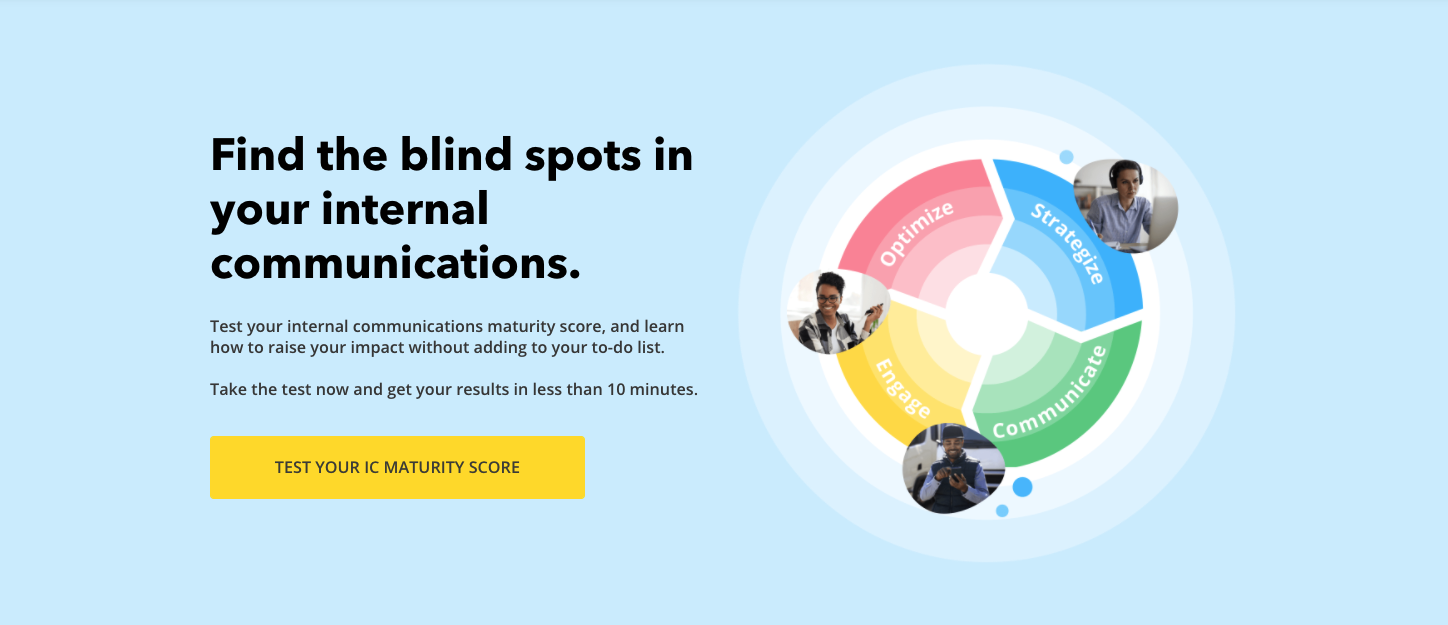
Find the blind spots in your internal communications. Take the Comms maturity test.
The opportunity for internal communication: A first aid kit for transformation
The forces shaping healthcare today — from staffing challenges to digital disruption — require a proactive communication strategy. The right tools and tactics can help healthcare organizations build a connected, informed workforce capable of delivering exceptional care.
Imagine a healthcare environment where:
- Every employee — from frontline nurses to administrators — feels informed, supported, and empowered to provide outstanding care.
- Leaders communicate with clarity and purpose, building trust during both everyday operations and critical incidents.
- Modern tools make it easy to deliver targeted, relevant messages that reduce information overload and improve focus.
- Employees feel recognized, valued, and connected to your organization’s mission — fostering retention and engagement.
In healthcare, clear communication isn’t just a tool — it’s a lifeline. The next chapters of this playbook will provide the tools and strategies you need to build a stronger, healthier communication strategy for your organization.
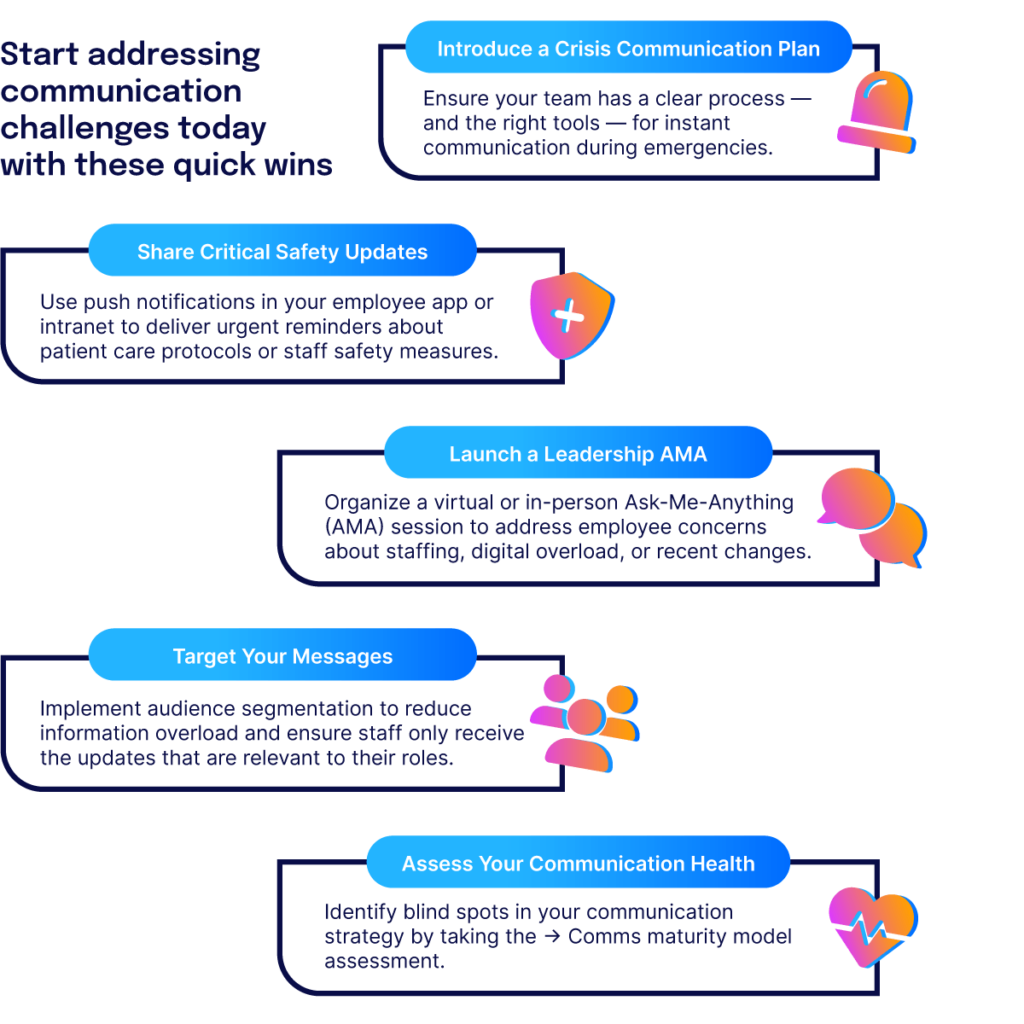

Healthcare is a story of careful coordination and accurate communication. From the front desk to the operating room, success depends on teams working in sync — and that requires clear, timely communication that cuts through the noise and reaches every employee.
Yet too often, internal communication fails to meet these same standards. Messages get lost in crowded inboxes, frontline staff miss important updates, and employees feel disconnected from leadership and their organization’s mission.
Building a thriving, connected healthcare workforce requires a finely tuned communication strategy that starts with understanding your people, includes everyone, and modernizes how messages flow across your organization — forming the foundation of your healthcare communication first aid kit.
How to equip your organization with the right tools to connect and engage
Know your audience
In healthcare, no two employees are the same. From nurses to physicians to administrative staff, every role has different priorities, communication needs, and access to tools. Yet many organizations still treat communication as one-size-fits-all — leading to messages that miss the mark.
Understanding your audience is the first step to effective communication. By mapping out who your employees are — their roles, locations, and schedules — you can tailor your communication approach to ensure messages are relevant and actionable.
A frontline nurse working back-to-back shifts won’t have the same access to a computer as an HR specialist based in the hospital’s administrative offices. Meanwhile, long-tenured employees may prefer traditional email updates, while newer staff may gravitate toward mobile alerts or short-form video content.
The best way to close these gaps is to listen to your employees. Use tools like surveys, focus groups, and audits to identify communication pain points and preferences. Ask questions like:
- Where do you get your information today?
- What tools do you need to feel more connected?
- What frustrates you about how we communicate?
This level of audience insight ensures every message has the right purpose, tone, and delivery method for the people it’s meant to reach.
Pro Tip: Healthcare organizations can face even greater communication challenges due to shift work, part-time staff, and frequent role changes. Regularly updating audience maps ensures your communication stays relevant and effective.
Design an inclusive strategy
Healthcare environments are among the most diverse workplaces — spanning multiple generations, languages, and cultural backgrounds. This diversity makes an inclusive communication strategy essential.
Consider the reality: Many healthcare workers are non-native speakers. Some employees prefer visual updates over lengthy emails. Others — particularly younger generations — may ignore traditional channels altogether in favor of fast, mobile-first content.
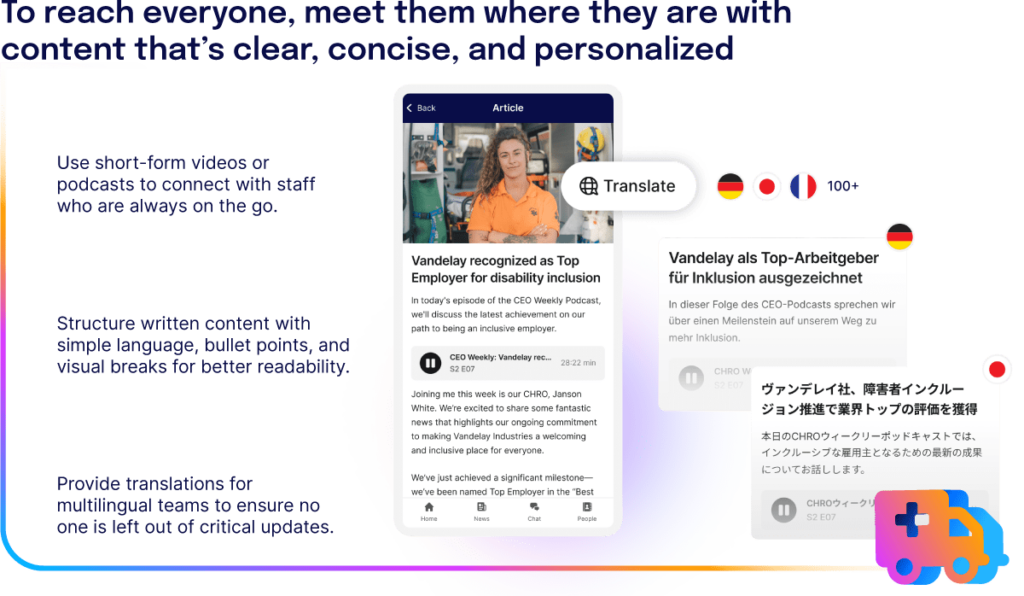
Inclusive strategies build bridges. They say, “We see you, we value you, and we want to communicate with you in ways that work for you.” This human-centered approach transforms communication into a tool for connection, engagement, and belonging.
By embracing this mindset, healthcare organizations can break down communication barriers and foster stronger engagement across their workforce.
Modernize your channels
In healthcare, outdated communication methods are all too common. While tools like email remain essential, many organizations rely too heavily on slow, fragmented methods like paper notices, word-of-mouth updates, or email messages that frontline staff rarely see.
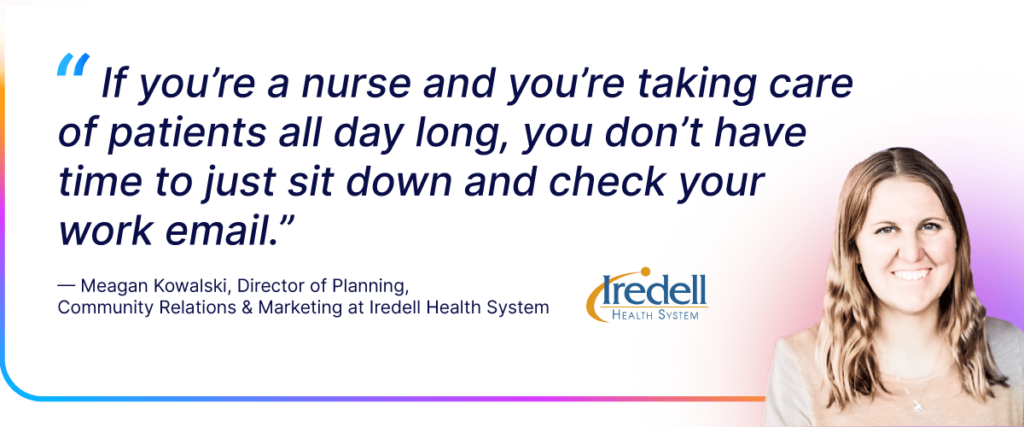
Modern healthcare communication requires modern channels. Start by developing a clear channel strategy that reduces noise and ensures messages are delivered where employees are most likely to see them:
- For frontline staff: Prioritize mobile-first tools that deliver updates directly to employees’ personal devices, reducing the risk of missed messages during busy shifts.
- For clinical teams on the go: Use branded push notifications to alert staff about urgent updates without overwhelming their inbox.
- For desk-based roles: Improve email effectiveness by segmenting audiences and ensuring each message is timely, relevant, and actionable.
- For integrations with digital tools like Microsoft Teams: Deliver updates directly in the platforms your employees already use to reduce context switching and ensure information fits naturally into daily workflows.
The goal isn’t to add more channels — it’s to ensure every channel has purpose and impact. For communicators, this approach reduces complexity by providing a single, integrated system that’s easy to manage, track, and measure.
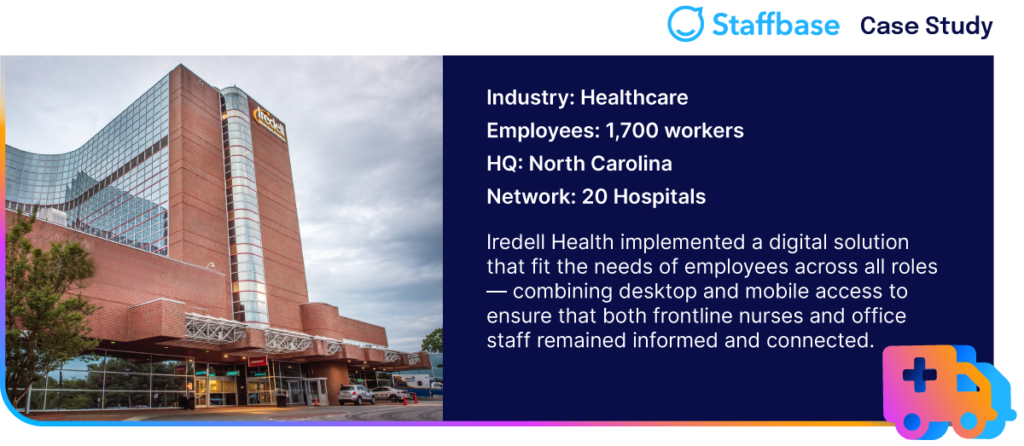
Building the foundation for success
Knowing your audience, designing inclusive communication, and modernizing your channels are not separate steps — they work together to create a seamless communication ecosystem. When you combine these tools, your messages will:
- Reach every employee, regardless of role, location, or device.
- Resonate with staff in ways that are clear, engaging, and meaningful.
- Reduce noise and build trust by delivering the right messages, through the right channels, at the right time.
By following these foundational steps, you’ll ensure that every worker feels seen, heard, and connected to your organization’s goals.
In the next chapter, we’ll explore the practical ways you can align leadership, empower managers, and drive trust across your healthcare workforce.
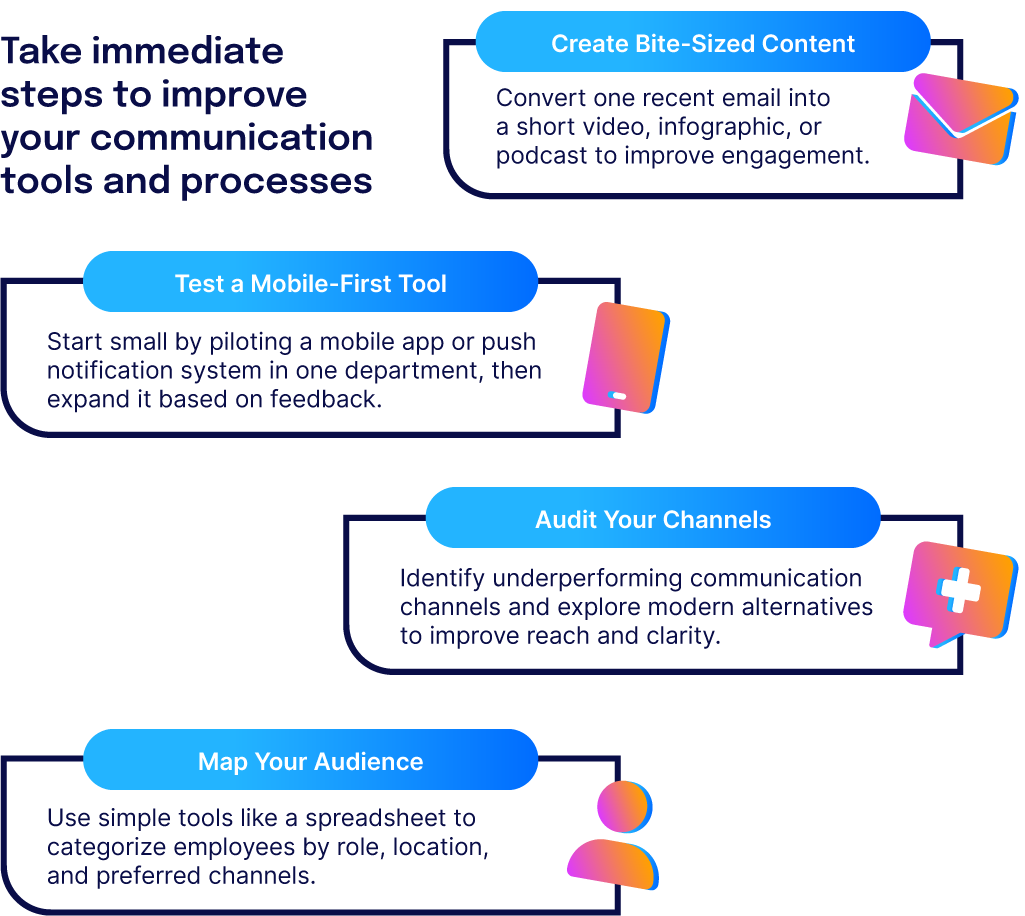

In healthcare, effective communication isn’t just about sharing updates — it’s about building trust, ensuring clarity during change, and supporting staff in their fast-paced, high-pressure roles. To achieve this, healthcare leaders must create a communication framework that promotes visibility, simplifies access to information, and strengthens engagement at every stage of the employee journey.
When Robins’ Nest merged with two other mental health providers to become Acenda Integrated Health, clear communication was key to uniting hundreds of employees under one brand. By launching an employee app alongside their rebrand, Acenda kept staff informed and connected — achieving 98% app registration and 77% regular active usage nearly six years later.
1. Promote leadership visibility and trust
In healthcare organizations — where frontline staff are often separated from senior leadership — visibility is critical. Employees want to hear directly from leaders, especially during moments of change, uncertainty, or growth. Yet, many healthcare leaders underestimate their role in communication, assuming that cascading messages through managers is enough.
It isn’t.
According to Gallup, 81% of employees feel leadership communication should be more effective, while Gartner reports that only 38% of employees today are willing to support organizational change — down from 74% in 2016.
When leaders communicate frequently, transparently, and authentically, employees feel connected to the organization’s mission and confident in its direction.
Practical steps to improve leadership visibility:
- Host regular town halls or AMAs (Ask Me Anything) to create a space where employees can hear directly from leadership and ask questions.
- Use short, personalized video updates to share insights on strategy, challenges, and success stories.
- Create two-way communication channels — like digital feedback forums — to ensure employees feel heard and valued.
2. Make information and tools easy to access for busy employees
In fast-paced healthcare environments, employees juggle urgent patient care tasks, constant updates, and administrative duties. When information is difficult to access or overwhelming to manage, mistakes can happen.
Studies show that:
- 80% of global workers experience information overload. (Big Data Wire)
- 27% of employees say they use 11 or more digital resources each day to do their jobs. (Big Data Wire)
- Poor communication is linked to 30% of medical malpractice cases in the United States, costing $1.7 billion in claims. (HIPAA Journal)
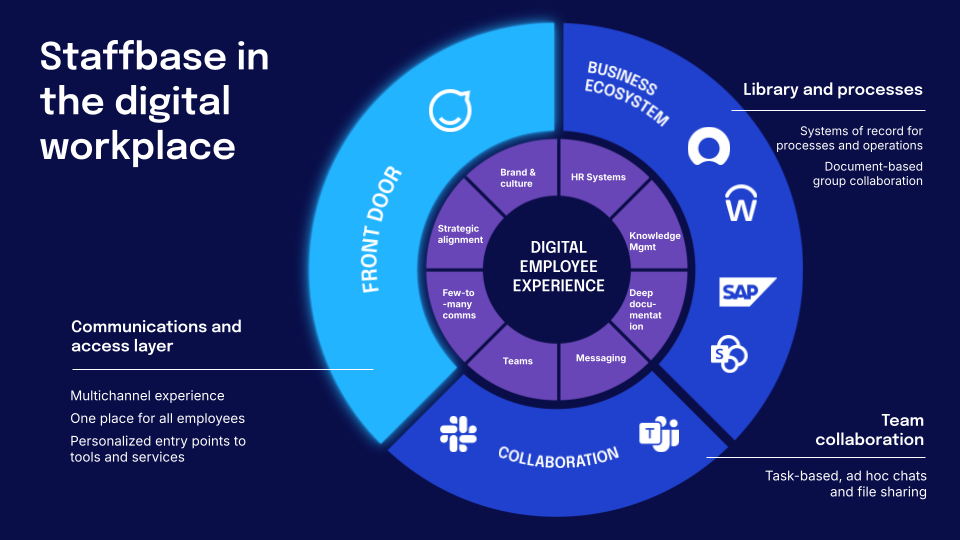
Practical steps to simplify access to information:
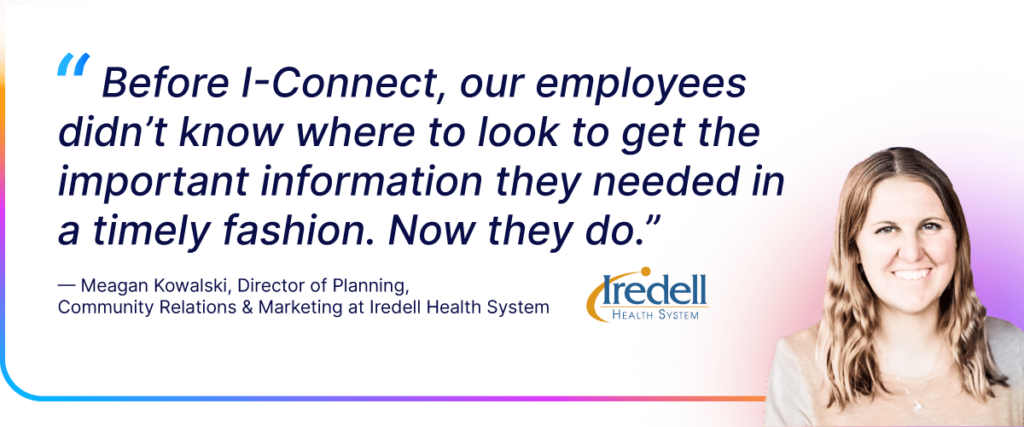
3. Master key moments in the employee journey
In healthcare, onboarding is make-or-break. Research shows that 59% of hospital staff turnover happens within the first year of employment. Poor onboarding experiences leave employees feeling overwhelmed, undervalued, and unprepared — ultimately driving disengagement and turnover.
A strong onboarding process, however, builds connection, confidence, and loyalty from day one.
Onboarding is more than paperwork — it’s your first chance to build trust and boost retention. Watch the full version of the above interview to learn how thoughtful onboarding can transform the employee experience.
Practical steps to improve onboarding and employee retention:
- Automate onboarding workflows to provide timely, bite-sized access to critical resources like safety protocols, schedules, and HR tools.
- Integrate culture-building content into the onboarding experience, reinforcing your organization’s values and mission.
- Use digital tools to provide new hires with a central hub for information, updates, and peer connections.

Get everything you need to build a better onboarding experience. Read the complete guide to employee onboarding.
4. Build a culture that’s purpose-driven and celebrates employees
Feeling undervalued is a significant factor in healthcare turnover. In fact, 70% of nurses considering leaving the profession cited feeling undervalued as a main reason.
Healthcare employees are driven by purpose — their work directly impacts lives — but this dedication can often go unrecognized. Fostering a culture that celebrates employees is essential to building engagement and loyalty.
Practical steps to inspire and celebrate your workforce:
- Regularly share stories of purpose-driven work to highlight the impact employees are making on patients and the community.
- Use automated recognition tools to celebrate milestones like work anniversaries, promotions, or certifications.
- Create social walls or online communities where employees can connect, share achievements, and build relationships.
5. Prepare for crisis communication
In healthcare, crises are not a question of if — they’re a question of when. Whether it’s a natural disaster, cyberattack, or medical emergency, effective communication can mean the difference between chaos and control.
In crisis situations, delays or unclear communication put both employees and patients at risk. According to research, the number one failure during hospital disasters is often communication breakdown.
Practical steps to prepare for crisis communication:
- Develop a clear BCDR (Business Continuity and Disaster Recovery) plan that outlines communication protocols during emergencies.
- Implement branded push notifications and SMS alerts to deliver urgent updates directly to employees’ devices.
- Ensure access to third-party support tools to maintain communication if internal systems fail.

A framework for success
Promoting leadership visibility, simplifying access to information, strengthening onboarding, and preparing for crises aren’t standalone actions — they are the pillars of a resilient healthcare communication framework.
Together, these steps create an environment where:
- Leaders earn trust through transparency and accessibility.
- Employees feel connected to their organization’s mission.
- New hires are engaged, informed, and set up for success.
- Teams respond effectively and confidently during emergencies.
By building this framework, healthcare organizations can foster a stronger, more connected workforce — ensuring that communication isn’t just a tool, but a lifeline that empowers staff and improves patient care.


You’ve built your healthcare communication first aid kit. You’ve addressed challenges, modernized tools, empowered leaders, and connected teams. But how do you know if it’s working? How can you ensure your communication strategy isn’t just another initiative — but a driver of real, measurable outcomes that improve both employee well-being and patient care?
How to know your communication framework is delivering impact
In healthcare, success is measured by outcomes. Clinicians track recovery rates, patient satisfaction scores, and operational efficiency. Internal communication deserves the same focus — not just measuring what’s sent, but what’s seen, understood, and acted upon.
By shifting from tracking outputs (like message volume) to measuring outcomes (like improved engagement or reduced errors), healthcare leaders can connect communication efforts to vital business goals — whether that’s lowering staff turnover, improving safety protocols, or strengthening employee trust.
Why measurement matters
Too often, communication success is measured by surface-level metrics: the number of emails sent, meetings held, or intranet views.

Measuring communication outcomes helps identify what’s working, where gaps exist, and how communication drives healthcare goals. By connecting communication strategies to tangible outcomes — like improved retention, reduced medical errors, or enhanced crisis response — leaders can ensure their efforts deliver lasting impact.
Defining success: 3 critical outcomes
To build a connected, engaged, and resilient healthcare workforce, communication success should focus on three measurable outcomes:
Outcome 1. A connected workforce
- What it looks like: Employees feel informed, aligned, and equipped with the information they need — even during crises or emergencies. Staff know where to get information, they trust its accuracy, and they respond accordingly.
- Key metric: Message reach and acknowledgment rates
- Why it matters: In a healthcare crisis — whether it’s a cyberattack, power outage, or urgent safety update — every second counts. Ensuring employees receive clear, timely information can prevent confusion and improve response times.
Example: During Hurricane Beryl, a pharmacy chain with more than 330,000 employees and 750+ locations used mobile push notifications to keep staff informed. Employees received updates in real time, ensuring continuity of care and employee safety during the disruption.
Outcome 2. Engaged employees
- What it looks like: Employees feel connected to the organization’s purpose and values, understand their role in delivering excellent patient care, and actively participate in organizational initiatives.
- Key metric: Retention rates and employee sentiment scores
- Why it matters: Healthcare organizations lose valuable talent when employees feel disconnected or overwhelmed. Improved communication during onboarding and day-to-day operations can reduce burnout and improve retention.
Example: Acenda Integrated Health successfully onboarded hundreds of new employees following a merger by launching an employee app to provide seamless communication. With 98% app registration and 77% active usage, the app continues to drive shared communication and culture — nearly six years post-launch.
Outcome 3. Inspired advocates
- What it looks like: Employees do more than just understand company goals — they champion them. They feel recognized for their contributions, take pride in their roles, and become vocal supporters of your organization.
- Key metric: Alignment scores, employee feedback, and engagement with key initiatives
- Why it matters: Employees who feel connected to their organization’s mission deliver better care, improve team morale, and advocate for their workplace in their communities.
Example: After Bethany Children’s Health Center introduced the Staffbase “Journeys” tool to support employee onboarding and engagement, new staff reported feeling more confident and prepared. The tool continues to reinforce culture and connect staff with purpose — driving higher retention and engagement scores.
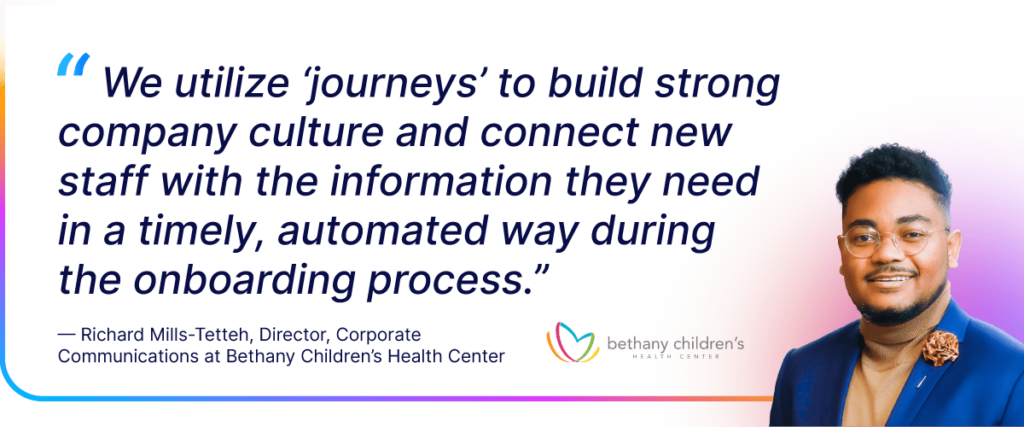
How to measure communication success
Building a healthcare communication measurement framework doesn’t need to be complex. Start with clear objectives tied to healthcare priorities, then track performance across three key areas:

Turning insights into action
In healthcare, communication doesn’t just improve employee engagement — it saves time, builds trust, and directly impacts patient care. By measuring communication outcomes and linking those results to broader organizational goals, healthcare leaders can ensure their strategies deliver measurable value.
When healthcare employees feel informed, connected, and recognized, they are better equipped to provide exceptional care — and that’s the ultimate measure of success.

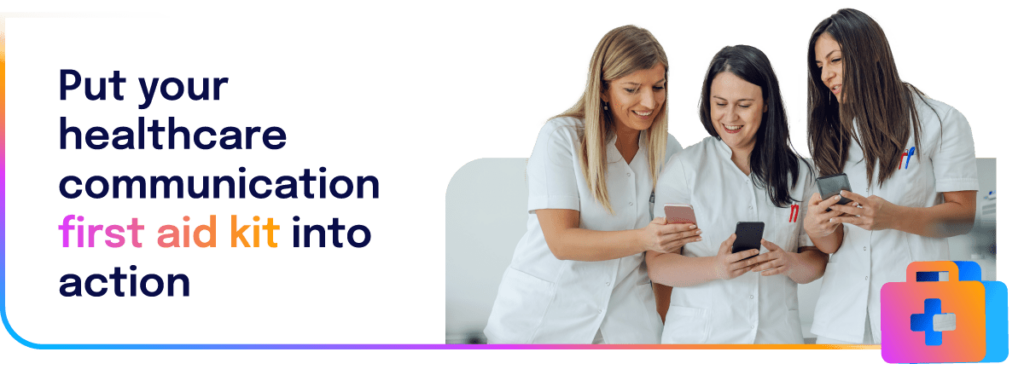
Success in healthcare depends on a workforce that is informed, connected, and supported. When communication works, employees don’t just receive updates — they trust them, act on them, and use them to deliver better care.
This playbook has equipped you with the essential tools, strategies, and steps to build a resilient communication framework for your healthcare organization:
- Understand your workforce and tailor communication to meet diverse needs.
- Empower leaders and managers to build trust and visibility.
- Strengthen onboarding to boost retention and reduce early turnover.
- Prepare for emergencies with fast, reliable crisis communication.
- Measure impact to ensure communication supports both staff well-being and patient outcomes.
With this first aid kit, you’re not just sending information — you’re supporting the people behind every patient interaction, every shift, and every decision.


